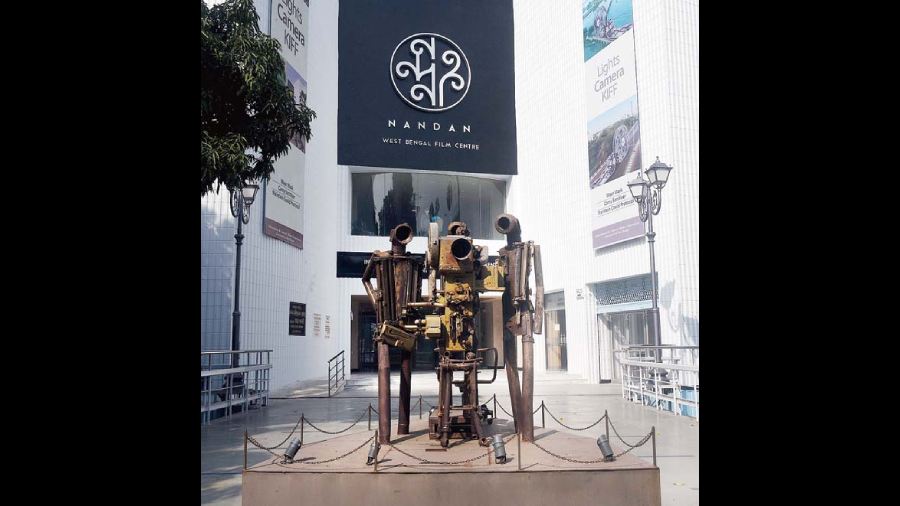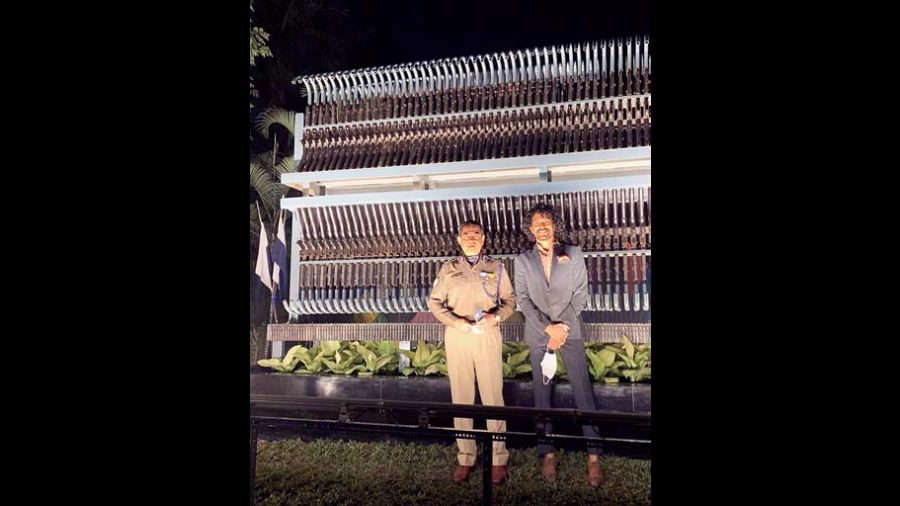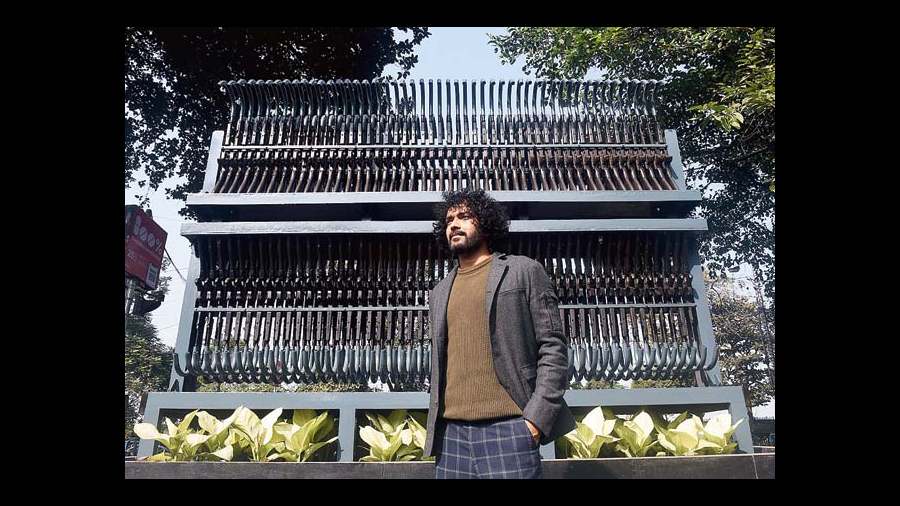Narayan Sinha’s year has begun with a plea. The artist has a humble request to help him in his quest to enrich Kolkata with its very legacy and soul, which is slowly and surely getting lost. Forever. He wants to pursue public art projects that will capture the legacy of the city at its heart, and present it in a contemporary language that can then travel to the global Bengali and world at large. His gleaming ‘Discipline Symphony’ that stands tall at Kolkata Police Training School, Dalanda House, AJC Bose Road, is a tiny step in that direction. Inaugurated last month, Narayan found Soumen Mitra, the former police commissioner of Kolkata and now the officer on special duty and director, training, beside him, in this endeavour. With his trademark candour intact, Narayan, the curly-haired maverick, tells The Telegraph why he feels he has a winner on his hands.

Narayan’s ‘Capture’ that trains the lens of the audience, has been at Nandan since 2019. Pabitra Das
How did the association come about?
Kolkata is steeped in nostalgia and history. That is somehow not getting reflected in the public art space. As an artist, I have taken an initiative to capture Kolkata’s history in a contemporary way. Soumenda also believes in restoration and he has restored many. I have known him for 18 years and the association was strong. I have done one at the Swami Vivekananda State Police Academy, West Bengal, Barrackpore, four years back, with used bullet cases and used ammunition boxes.
You need funds and a big space and also KMC’s (Kolkata Municipal Corporation) permission. Getting all three was becoming difficult. Soumenda gave me access to a few places. The Kolkata Police Training School installation is our second venture. BYJU’S has sponsored this. This is an expensive sculpture and I have just taken the basic material cost.
Tell us about Discipline Symphony...
It is 10ft by 13ft and has taken almost three-four years to put together. Soumenda told me that there were a lot of arms lying around at the Training School. There is so much unrest in the entire world and weapons and muscle power are being used to subjugate the other. I am opposed to it. So, I didn’t really want to work with weapons, but then I thought how best can I use this in my subject.
We live in an ecosystem where you do need some sort of discipline. So, weapons don’t necessarily mean violence. The fact that we have police makes our society safe. The spirit to obey might lead to harmony. I started on that note.
The weapons were stacked on a rifle stand that dated back to the British era. It looked like piano ribs or a harmonium. And they stood out in their stillness.
The installation has two parts. The upper part has bent rifles which are not used any more, almost 200 of them and I have put used magazines at the bottom. The weapon is present as a symbolic representation and I have stripped it of its power. The base is life. I have put a lot of greens on the pedestal.
It’s as if a conversation is taking place and conversation can solve many things. The message is we should talk it out and not fight and try to conquer one another. The conversation cannot be a power-centric one and there has to be equality.
The entire piece looks like a harmonium. The look is international and a dramatic and bold sculpture. When you stand next to it, you feel that energy, symphony and discipline. We have used iron joists, nuts and bolts from our Nalhati factory. Fifty per cent of the installation has been put together in the Nalhati factory and the rest of it has been assembled here.
What is your future plan?
This is not about a lone installation. This is an initiative and the process will continue from my end at least. If the government extends a helping hand, it’ll be great. I also look forward to the support from the industrialists and entrepreneurs. There are lots of spaces in Kolkata and they are just lying vacant where I want to mount installations there. This is not a money-making venture. This is a gift from my end. We have spotted quite a few locations and they can be our next venture.
Those who will read this, it’s my humble request to them, as an artist, civilian and Calcuttan, if they come forward, ektu jaiga dae and bear the cost of basic raw materials, I will take out time for my Kolkata and work.
You have to understand that celebration is the key to life and so is surrender to Mother Nature. Harmony should prevail. I want to establish all of these through my work. The young generation may have gone global but you should not ignore the roots. I want to preserve our history which might become extinct. I have 50 ready sketches.
I also want to build something on the lines of Santiniketan’s Upasana Griha and open-air spaces. Mofussil students often don’t get a place to stay in the city. We can build a space for them which can then be let out at a minimum rate.
If you respect artists, then a symphony will be created in the society. Buildings are being demolished every day. A new city can emerge from the rubble but keeping the roots intact. I don’t need remuneration, but aami aamar shohor ke shajate chai buk bhore. That is my message. And, I am confident I’ll be able to do it.

Soumen Mitra, the former police commissioner of Kolkata and now the officer on special duty and director, training, with Narayan Sinha

